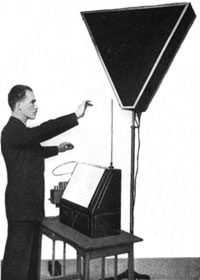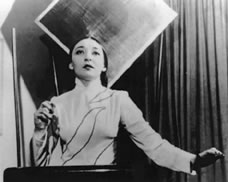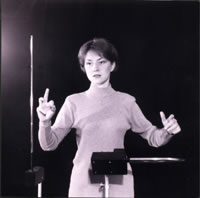|
"I
wanted to invent some kind of an instrument that
would not operate mechanically, as does the piano,
or the cello and the violin, whose bow movements
can be compared to those of a saw. I conceived of
an instrument that would create sound without using
any mechanical energy, like the conductor of an
orchestra"
--
Leon Theremin
|
 |
"Don't forget that you are dealing with air!
Think of your fingers as delicate butterfly wings,
and you will get much further than if you use
strength"
--
Clara Rockmore
|
"I was interested in making a different kind
of instrument. And I wanted, of course, to make
an apparatus that would be controlled in space,
exploiting electrical fields, and that would use
little energy. Therefore I used electronic technology
to create a musical instrument that would provide
greater resources"
--
Leon Theremin
|
|
What is a Theremin?
The Theremin is one
of the earliest electronic instruments, and is played
without ever physically touching it. Outfitted
with two antennas, a magnetic field surrounds the instrument,
and when the hands of the player enter the field, changes
in pitch and volume occur. The left side controls the
volume, and the right controls the pitch.
Sound futuristic?
The Theremin was patented in 1921. The instrument was
invented by Russian physicist Lev Sergeivitch Termen.
The sound is produced by two oscillators that "beat"
together. One oscillator operates in a frequency range
above the level of human hearing, while the other is varied
when the hands enter the magnetic field. The "beat
frequency" is the difference between the two oscillators,
which is the sound that is heard. The Theremin was originally
patented and called the Ætherphone, which means "music
from the ether".
The Theremin and its
workings caught the attention of Soviet leader Vladimir
Il’yich Lenin when it was shown in Moscow in 1922.
Termen, whose "westernized"
name is Leon Theremin, arrived in the US in 1928, and
much interest surrounded his new invention in New York
society. Albert Einstein was a frequent house guest, interested
in the more technical nature of the Theremin's phenomena.
Theremin's were produced by the RCA Victor company. A
full 10 piece Theremin-only orchestra even played Carnegie
Hall. Being an instrument
that is very easy to make sound with, but quite difficult
to play well, the Theremin did not enjoy mass appeal from
musicians, and only a few great players were ever produced.
The most notable being his protégé Clara
Rockmore (1911-1998), who played solo and with symphony
orchestras around the world.
Leon Theremin disappeared
from the free world in in 1938, and was "escorted"
to Communist Russia, he did not emerge for 51 years. A
victim of Stalinism and the Cold War, he was thrown into
a gulag and later put to work in a secret KGB lab. There,
he invented listening devices (the bug), alarm systems,
one of the first televisions, and other non-musical devices
that used technology similar to the Theremin. He was not
allowed to leave Russia until 1989 at the age of 93. In
1989, the first interview with Leon Theremin since his
disappearance was conducted by Olivia Mattis in France upon his arrival, which we are pleased to reprint on this website.
The Theremin's sound
enjoyed cult status in many sci-fi movies of the 1950's,
being used for spooky sounding effects, but Clara Rockmore
refused to play in any those soundtracks, because she
played the Theremin as a "serious classical instrument"
and felt it demeaned the instrument. Theremin, being sequestered
in Russia, was completely unaware of this usage of the
instrument.

Clara
Rockmore |

Lydia
Kavina |
The Theremin is still a popular instrument today, used
in movies, and by a number of musicians, and has undergone
a new resurgence, used by bands from Led Zeppelin to Radiohead
to Nine Inch Nails, and also played in more traditional
and classical styles. His last protégé,
and grand-niece Lydia Kavina is now one of the
leading classical Thereminists today.
While finding an original vacuum tube RCA Theremin is
nearly impossible, more modern Theremin's are manufactured
today. One which most captures the classic Theremin
sound, along with other features, is the late Robert Moog's
EtherWave Pro. Moog built homemade Theremin's in his teens,
and later created the famous Moog synthesizer in the 1960's
and the company he founded still thrives, making Theremin's,
analog synthesizers and effects units. |